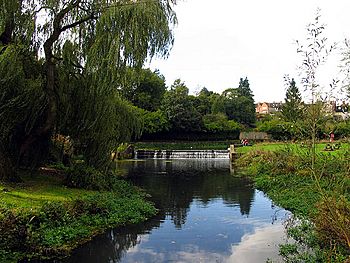Tetbury Avon facts for kids
Quick facts for kids Tetbury Avon |
|
|---|---|

Tetbury Avon near Malmesbury
|
|
| Native name | Ingleburn |
| Other name(s) | Little Avon |
| Country | England |
| Region | West of England |
| District | Gloucestershire, Wiltshire |
| City | Tetbury, Malmesbury |
| Physical characteristics | |
| Main source | Wor Well Tetbury, Gloucestershire, England 375 ft (114 m) 51°38′36″N 2°08′33″W / 51.6432°N 2.1424°W |
| River mouth | Bristol Avon Malmesbury, Wiltshire, England 230 ft (70 m) 51°34′56″N 2°05′34″W / 51.5821°N 2.09289°W |
| Length | 7 mi (11 km), south easterly |
| Basin features | |
| Basin size | 28.5 sq mi (74 km2) |
| Tributaries |
|
| River system | Bristol Avon |
The Tetbury Avon is a small river in England. It is also known as the Little Avon or the Ingleburn. The name Ingleburn comes from an old Anglo-Saxon word for "English river."
This river is a "tributary" of the Bristol Avon. This means it is a smaller river that flows into a larger one. The Tetbury Avon starts near Tetbury in Gloucestershire. It then flows southeast and joins another river, the Sherston Avon, near Malmesbury in Wiltshire.
In the past, people used the river's power to run watermills. These mills helped to prepare wool and grind corn. Today, one of these old mills is still working.
Contents
Where Does the Tetbury Avon Flow?
The Tetbury Avon begins at a place called Wor Well. This spot is northeast of Tetbury in the Cotswold Hills. First, the river flows south. It is joined by the Cutwell Brook on its right side.
Journey Through the Valley
The river then turns southeast. It flows through a steep valley in Estcourt Park. Here, another stream, the Wormwell Brook, joins it. The Wormwell Brook starts near Westonbirt.
As the river passes through Shipton Wood, it forms a lake. This lake was made in the late 1700s for the Estcourt Estate. The river then enters Wiltshire near the village of Brokenborough. It flows north of Malmesbury. Finally, it meets the Sherston Avon at the eastern edge of the town.
How Were Watermills Used?
Many watermills were built along the Tetbury Avon a long time ago. This was common for rivers in the Cotswolds. These mills were used for two main jobs. One was "fulling" wool, which means cleaning and thickening it. The other was grinding corn to make flour.
Shipton Mill's Long History
Shipton Mill, located in Shipton Wood, is still active today. It produces organic wheat and rye flours. Records show that a mill has been on this site since 1086. This was the year the Domesday Book was written.
What About the River's Wildlife?
The Tetbury Avon used to have a type of native crayfish called the white-clawed crayfish. Sadly, these native crayfish have disappeared from the river.
Why Did the Crayfish Disappear?
They were harmed by a fungus. This fungus was carried by an invasive crayfish from North America. This new crayfish is called the signal crayfish. Invasive species can cause problems for local wildlife.
How Much Water Flows in the River?
The Environment Agency measures the water flow in the Tetbury Avon. They have a station at Brokenborough. On average, the river flows at about 24.4 cubic feet per second. At its highest, it can flow at 141 cubic feet per second. At its lowest, it flows at 1 cubic foot per second.
Why is Water Flow Important?
Some people believe that taking water from the Great Oolite aquifer (an underground water source) in the Cotswolds has lowered the river's flow. This can make it harder to keep the water clean. It can also negatively affect the plants and animals living in the river.

